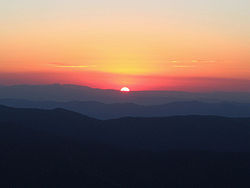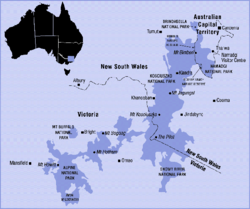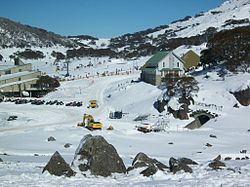- Australian Alps
-
Australian Alps The Alps, Victorian Alps, Snowy Mountains, New South Wales Alps Mountain range Mount Hotham, looking towards Mount Feathertop; during winter these mountains are blanketed in snowCountry Australia Region Victoria, New South Wales Part of Great Dividing Range Highest point Mount Kosciuszko - elevation 2,228 m (7,310 ft) Geology Igneous, Sedimentary, Metamorphic Period Devonian  Sunset over the alps from Mount Hotham, Victoria
Sunset over the alps from Mount Hotham, Victoria
The Australian Alps are the highest mountain ranges of mainland Australia. They are located in southeastern Australia and straddle the Australian Capital Territory, south-eastern New South Wales and eastern Victoria. The Alps contain the Australian mainland's only peaks exceeding 2,000 metres (6,500 feet) and the only place on the mainland in which deep snow occurs regularly (snow also falls on Tasmania's high country).
The Australian Alps are part of the Great Dividing Range, the series of hills and plateaus which run about 3,000 kilometres from northern Queensland to central Victoria. These highlands divide the rivers and streams which flow eastwards into the Pacific Ocean, from those rivers and streams which flow inland to the Murray River system or internal catchments. The highlands reach their greatest height in the Alps.
The Snowy Mountains in New South Wales are part of the Alps. The southwestern half of the Australian Alps, in Victoria, are also referred to as the Victorian Alps. In and around the Australian Capital Territory, the mountains are known as the Brindabella Ranges.
Contents
Ecology
The Alps are important for conservation, recreation and as a water catchment, with much of the eastern slopes' runoff diverted into the Murray River and its tributary the Murrumbidgee River through the Snowy Mountains Scheme.
They are protected by large National Parks, in particular the Kosciuszko National Park in New South Wales and the Alpine National Park in Victoria which are managed cooperatively as Australian Alps National Parks by agencies of the Australian, New South Wales, Victorian and Australian Capital Territory governments.
They also contain mainland Australia's only ski resorts, which along with the Snowy Mountains Scheme town of Cabramurra represent virtually the only permanent settlements in the area. Several medium-sized towns are present in the valleys immediately below including Jindabyne, Corryong and Mount Beauty.
The Australian Alps are mostly considerably less steep in character than the Alps, and most peaks can be reached without specialised mountaineering equipment (though there are some cliffs suitable for abseiling and rock climbing).
Birds
The Australian Alps have been classified by BirdLife International as an Important Bird Area. Their montane forests and woodlands support large breeding populations of Flame Robins and Pilotbirds.[1]
Bushfires
Due to its mostly hot, dry climate, bushfires in Australia occur frequently, particularly in the well forested areas of the Australian Alps. The Alps, particularly the Victorian Alps, are periodically subject to major bushfires and have been almost entirely burnt through by bushfires on various occasions, notably; Black Thursday in 1851, Black Friday (1939), and during fires in 2003 and 2006-07.
Certain native flora in Australia have evolved to rely on bushfires as a means of reproduction and fire events are an interwoven and an essential part of the ecology of the continent. In some eucalypt and banksia species, for example, fire causes seed pods to open, which allows them to germinate. Fire also encourages the growth of new grassland plants. Other species have adapted to recover quickly from fire.
Nevertheless, damage to surrounding human habitations and native fauna can be extensive and occasionally catastrophic. The 2003 Canberra bushfires severely affected almost 70% of the Australian Capital Territory’s pasture, forests (pine plantations) and nature parks. After burning for a week through the Brindabella Ranges above Canberra, the fires entered the suburbs of the city on 18 January 2003. Four people died and more than 500 homes were destroyed or severely damaged. The Victorian Black Saturday bushfires were particularly intense in parts of the Victorian Highcountry and destroyed several towns, including Kinglake and Marysville. The fires killed 173 people, Australia's highest ever loss of life from a bushfire.[2] Statewide, the fires affected 78 townships and destroyed over 2,030 houses, 3,500+ structures.[3]
Alpine huts
Within the Australian Alps there are 120 still active alpine huts that mainly originate from the early cattlemen days, ski huts, research and surveying. Many have remained in use by fly fishers (seasonal), hikers and skiing groups throughout the year. Most of these huts are maintained by volunteers through the Kosciuszko Huts Association and the local National Parks services.
Some of the more famous huts include Moscow Villa Hut, Valentine Hut, Seaman's Hut and Mawsons Hut. In recent years many huts have been lost through lack of maintenance and bush fire - as occurred with the Pretty Plain Hut and Mount Franklin Chalet, which were lost in the Bushfires of 2003.
Attractions
- Australian Alps Walking Track: a long distance walking trail through the alpine areas of Victoria, New South Wales and ACT. It is 655 km long, starting at Walhalla, Victoria and running through to Tharwa, ACT near Canberra.
New South Wales:
- Mount Kosciuszko, Mainland Australia's highest peak at 2,228 m (7,310 ft)
- Kosciuszko National Park
- Snowy Mountains
- Alpine Way
- Barry Way
- Snowy Mountains Highway
- Snowy Mountains Scheme
- Yarrangobilly Caves
- Kiandra gold & skifields (where Skiing in Australia began in the 1860s).
- Trout fishing in New South Wales
- Skiing in New South Wales
Victoria:
- Alpine National Park
- Baw Baw National Park
- Mount Buffalo National Park
- Mount Bogong, Victoria's highest peak at 1,986 m (6,516 ft)
- Mount Feathertop
- Bogong High Plains
- Great Alpine Road
- National Alpine Museum
- Lake Tali Karng
- Skiing in Victoria
Australian Capital Territory:
- Namadgi National Park
- Bimberi Nature Reserve
- Tidbinbilla Nature Reserve
- Bimberi Peak, the A.C.T.'s highest peak at 1,912 m.
- Tharwa Road
- Corin Forest
- Mount Franklin (Australian Capital Territory)
- Skiing in the Australian Capital Territory
Resort skiing areas
Main article: Skiing in Australia The Kosciuszko Main Range seen from Charlotte Pass ski resort.
The Kosciuszko Main Range seen from Charlotte Pass ski resort.
The Australian Alps are the main region in which skiing in Australia takes place (although skiing is also possible in Tasmania). Skiable terrain stretches through large areas of territory from June to October. New South Wales is home to Australia's highest snow country, oldest skifields and largest resort. Recreational skiing in Australia began around 1861 at Kiandra, New South Wales, when Norwegian gold miners introduced the idea to the frozen hills around the town.[4] The first and longest surviving ski club in the world, The Kiandra Snow Shoe Club is believed to have been formed at Kiandra in that year.[5][6] Steeper slopes and more reliable snows lie further to the south and in the 20th Century, the focus of recreational skiing in New South Wales shifted southward, to mountains in and around the Kosciuszko Main Range region, where Australia's best vertical drop is found at Thredbo and Australia's biggest resort, Perisher is now found.
Victoria is the State with the greatest number of ski resorts in Australia and skiing is conducted in ten different alpine locations.[7] Mount Bogong at 1986m, is the highest peak in Victoria and the surrounding Bogong High Plains provide one of the most extensive snow country in Australia, including the leading resorts of Falls Creek and Mount Hotham.[8] Recreational and practical skiing was being practised in the Victorian Alps by the 1880s and 90s with skis made from local timbers, and making use of single steering poles.[9] Skiing began at Mount Buffalo in the 1890s and a Chalet was constructed in 1910. Australia's first ski tow was constructed near Mount Buffalo in 1936.[10]
Cross country skiing is possible in the Australian Capital Territory as well as in New South Wales and Victoria, but downhill ski resorts currently exist only in New South Wales and Victoria:
-
- Perisher
- Perisher Valley
- Guthega
- Mount Blue Cow
- Smiggin Holes
- Thredbo
- Charlotte Pass
- Selwyn Snowfields
- Perisher
Victoria
-
- Mount Buller
- Falls Creek
- Mount Hotham
- Dinner Plain
- Mount Baw Baw
- Mount Buffalo
- Lake Mountain (cross country)
- Mount Stirling (cross country)
- Mount Saint Gwinear (cross country)
- Mount Donna Buang (snow play)
Panoramas
 The Victorian High Country from Mount Hotham
The Victorian High Country from Mount Hotham
 The Victorian Alps Fire Complex during the 2006-07 Australian bushfire season, looking towards Dargo from Swifts Creek
The Victorian Alps Fire Complex during the 2006-07 Australian bushfire season, looking towards Dargo from Swifts Creek
 Panoramic view of Thredbo ski resort and the Thredbo River valley in the Snowy Mountains from the Kosciuszko Express Terminal
Panoramic view of Thredbo ski resort and the Thredbo River valley in the Snowy Mountains from the Kosciuszko Express Terminal
References
- ^ "IBA: Australian Alps". Birdata. Birds Australia. http://www.birdata.com.au/iba.vm. Retrieved 2011-05-19.
- ^ Huxley, John (11 February 2009). "Horrific, but not the worst we've suffered". Fairfax Media (Sydney Morning Herald). http://www.smh.com.au/national/horrific-but-not-the-worst-weve-suffered-20090210-83ib.html. Retrieved 11 February 2009.
- ^ "Victorian Bushfires". Parliament of New South Wales. New South Wales Government. 13 March 2009. http://www.parliament.nsw.gov.au/prod/PARLMENT/hansart.nsf/V3Key/LA20090313005. Retrieved 14 December 2009.
- ^ Sydney Morning Herald, "Kiandra - Culture and History", The Sydney Morning Herald, http://www.smh.com.au/travel/travel-factsheet/kiandra--culture-and-history-20081121-6df7.html, retrieved 2010-05-04
- ^ Selwyn Snowfields, "History", Selwyn Snowfields Website, http://www.selwynsnow.com.au/templates/sel/page/page_html_standard.php?secID=69, retrieved 2010-05-04
- ^ Clarke, Norman W. (2006), "Kiandra: goldfields to skifields ISBN 0-646-46337-3", Kiandra Pioneer Ski Club (1870) Ltd
- ^ http://www.australia.com/articles/vic_snow_play.aspx
- ^ http://www.ga.gov.au/education/geoscience-basics/landforms/highest-mountains.jsp
- ^ Australian Alpine Club Heritage
- ^ http://www.australianalps.environment.gov.au/parks/mount-buffalo.html
External links
Categories:- IBRA regions
- IBRA subregions
- Mountain ranges of New South Wales
- Mountain ranges of Victoria (Australia)
- Regions of Victoria (Australia)
- Regions of New South Wales
- Important Bird Areas of Australia
Wikimedia Foundation. 2010.










